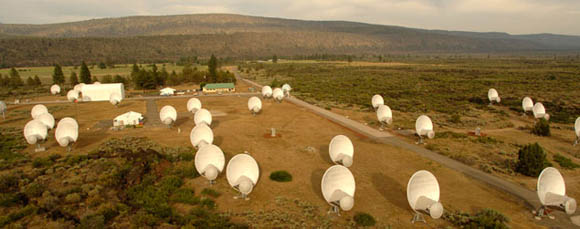This article is more than 1 year old
Shuttered SETI reboots ET pursuit
Thanks to Jodie Foster
The search for intelligent life somewhere other than among non-governmental homo sapiens has been given a reprieve. Thanks to private donations, the SETI Institute will soon resume scanning the skies for extraterrestrial signals.
"We are absolutely thrilled that thousands of people from all over the world stepped forward to declare their support for SETI science just when help was needed the most," the Institute notes on its website, saying that their sky-scouring will begin again next month.
The Institute's search for coherent radio signals that might indicate intelligent alien life, which was being conducted at the Allen Telescope Array (ATA) in Northern California's Hat Creek Valley, had to be suspended this April because of – what else? – budget cuts.

SETI's Allen Telescope Array – back in action this September
The Institute didn't buckle under, however. Instead, it launched a fundraising campaign that it dubbed SETIstars, with a goal of raising $200,000 to restart the ATA project.
As of this Monday morning, SETIstars had received $222,595 from over 2,000 donors, including science-fiction author Larry Niven (Ringworld), Apollo 8 astronaut Bill Anders, and actress Jodie Foster, who played an alien-discovering scientist in the 1997's Contact.
According to the Christian Science Monitor, Anders wrote about the shutdown: "It is absolutely irresponsible of the human race not to be searching for evidence of extraterrestrial intelligence."
Foster also weighed in: "The Allen Telescope Array could turn science fiction into science fact, but only if it is actively searching the skies." And speaking of big-name supporters, the 42-dish ATA itself was originally funded by a pair of gifts from Microsoft cofounder Paul Allen.
Although the restarting of the Institute's search is cause for all space-watchers to celebrate, there is a dark lining to this celestial cloud. When the Institute went dark in April, SETI Institute astronomer Jill Tarter told the San Francisco Chronicle that the search was costing the Institute – that is, its funders – $2.5m per year; $1.5m to light up the ATA, and $1m for the search effort.
Needless to say, $222,595 won't go very far towards doing much more than getting the seach off the mat – and briefly, at that. The ATA has other funders – the cash-strapped University of California is its primary other user, and SETI's senior astronomer Seth Shostak told a local newspaper that the US Air Force is likely to pick up the rest of the tab.
But with the budget of the US Deparment of Defense currently a prime target of ongoing budget battles, even the support of as powerful a friend as the Air Force may not be enough to allow the ATA to keep scanning the skies for intelligent life.
So the Institute is keeping SETIstars going, despite having surpassed its goal. "It's not too late to contribute," SETI's website notes. Should you feel generous, check our the Institute's donation page. ®
Bootnote
Not every sky-watcher is of the opinion that contacting an alien race is such a good idea. One of the brightest, Stephen Hawking, told the Times of London: "If aliens ever visit us, I think the outcome would be much as when Christopher Columbus first landed in America, which didn't turn out very well for the Native Americans."
